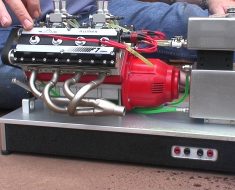Tables with beer bottle cap surfaces are a huge trend in DIY. It takes some planning and, depending on how big a beer drinker you are, months of bottle cap collecting. But the end result is worth it. Your favorite bottle caps are enshrined for all of time under a hard, clear resin table top, perfect for eating, card playing and, of course, serving beer.
1. Choose your table. Consider the size of your bottle cap collection. Even something the size of a coffee table can require as many as 800 bottle caps, so it might be best to shoot for a small end table or bistro table. Ideally the tabletop will be recessed with a shallow lip around the edge to hold the epoxy, although this is not necessary, as you will see in Step 6.
Thrift shop or yard sale tables are a good option because it doesn’t matter if the table top is chipped or scratched. Just make sure the table is sturdy enough to hold the epoxy, which can get weighty. Don’t use any table that does not have a solid surface, such as an open-mesh patio table.
2. Collect your bottlecaps. This can take some time, especially for a larger table. Ask friends and family, as well as your local bartender, to save their caps for you.
3. Prepare the table top. Make sure it is clean and dry. A bit of the tabletop surface will show through, so make sure it’s a color you like that contrasts well with the bottle caps. If not, paint it now.
4. Arrange your bottlecaps on the table. Some people go for a random pattern, arranging the different colored bottle caps any which way. This is an especially good approach if you’ve gathered your caps from many different people and end up with lots of non-matching caps. If you notice that you have quite a few repeaters or many caps of the same color, however, you might consider a pattern. One option is to spray paint your caps, if you want a specific color pattern.
If you attempt a pattern, choose one that will enhance the shape of your table. For example, for a round table try a bullseye pattern or a hexagon pattern, with each round made of a particular color of cap. For a rectangular or square table you could make an abstract mosaic, a sports team logo, or a state flag.
Cover the entire table top with bottle caps. Don’t leave any gaps between caps.
5. Glue the caps to the table. You may be tempted to skip this step, but don’t. When you pour the epoxy it can cause the bottle caps to shift if they are loose, ruining your pattern. They might even float to the top of the epoxy surface. So make sure the bottle caps are tightly secured. The gluing step is time-consuming, so be sure to set aside at least an evening.
Choose a heavy-duty glue to secure the bottle caps. Super glue is a good choice, as is Liquid Nails. Hot glue guns don’t provide a strong enough hold. Do not use any glue that expands as it dries, such as Gorilla glue. These types of glues might lift your bottle caps and ruin your pattern.
Allow the glue to dry thoroughly, or at least overnight.
6. Create a lip. If your table top is recessed and already has a high enough barrier, you can skip this step. If not, first cover the edge of the table — the part you do not want epoxy to stick to — with painter’s tape. Next, form the lip by taping strips of aluminum foil to the sides of the table with duct tape. What you are doing is building up the sides to create a kind of basin for the epoxy to rest in while it sets.
Aluminum foil is the best choice because it will easily peel off of the epoxy once it dries. Create as smooth an edge as possible. This is the shape your epoxy will mold to.
7. Apply the tile grout. This step is entirely optional. If you like the way your bottle cap table looks right now, proceed to Step 8. Otherwise, grout the spaces between the bottle caps for a finished look. This is another great way to hide the tabletop surface completely if you’re not fond of it.
Mix the grout according to package directions. Apply between the bottle caps, and all the way to the table lip, filling all gaps completely. Smooth the grouted surface with your grout float. You want an even surface, flush with the tops of the bottle caps. Clean the bottle caps with a damp (but not sopping) rag to remove the excess grout and allow the bottle caps to show through.
Allow the grout to dry thoroughly.
8. Prepare the epoxy. Be sure to use high-quality epoxy designed for table and bar tops, rather than a craft epoxy, which might dry cloudy or even have a yellow hue. Mix the epoxy according to package directions.
Epoxy can be difficult to work with. Before pouring your mixed epoxy onto your bottle cap table, pour some onto a similar surface as an experiment, to make sure the consistency is correct.
9. Pour the epoxy. For best results, pour thin layers, allowing each to dry before pouring the next layer. When the level of the epoxy has risen above the surface of the bottle caps, use your (clean) grout float to smooth the surface, if necessary. Most likely the epoxy will even itself out, if the table is on a level surface. Pour into the middle of the table, allowing the epoxy to seep outwards.
10. Blow torch the surface. Most likely you will see small air bubbles forming in the epoxy. Work quickly, as epoxy sets up fast. Pass the blow torch across the surface of the table, making sure to never let the flame touch the epoxy. The air bubbles should rise to the surface and vanish.
11. Wait. Give the epoxy at least two days to set up completely. Make sure the table is in a location where dust, hair, leaves, and other debris won’t fall on it and stick to the epoxy.
12. Remove the lip, if you made one. Very carefully, peel away the aluminum foil, duct tape, and painter’s tape. They should peel away from the dried resin cleanly. If bits of resin have seeped down over the edge of the table, chip them away with a razor blade or a small knife.







